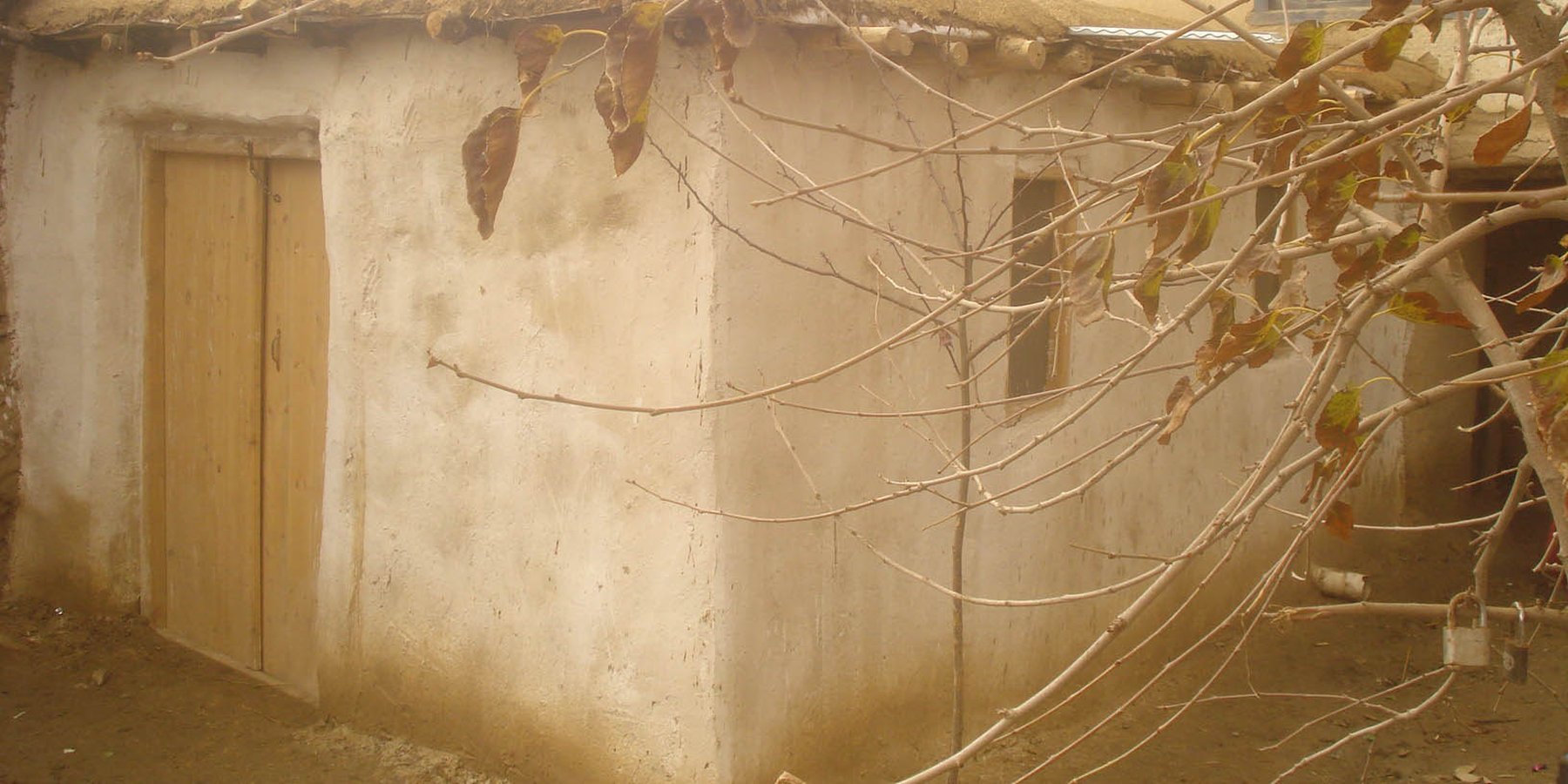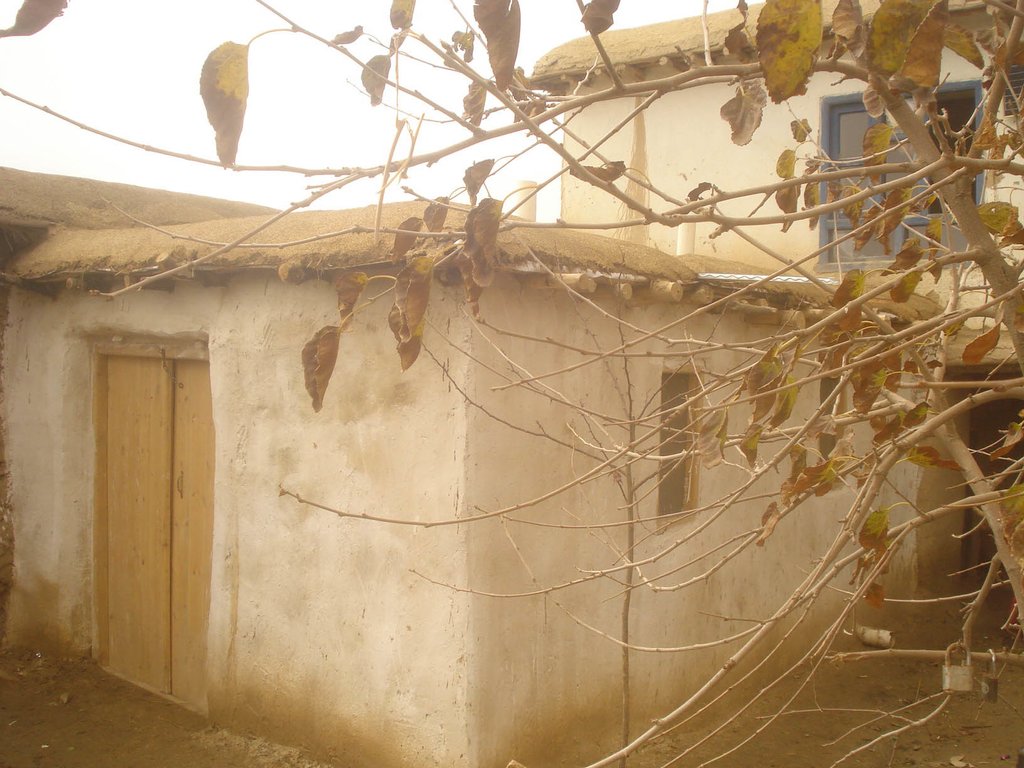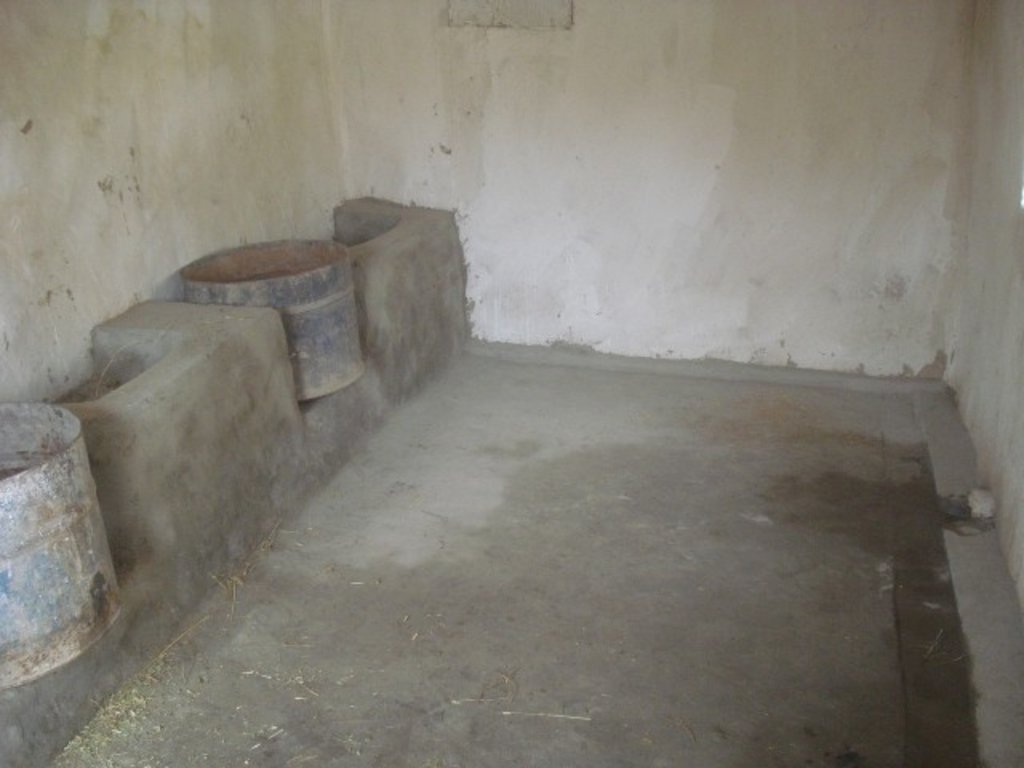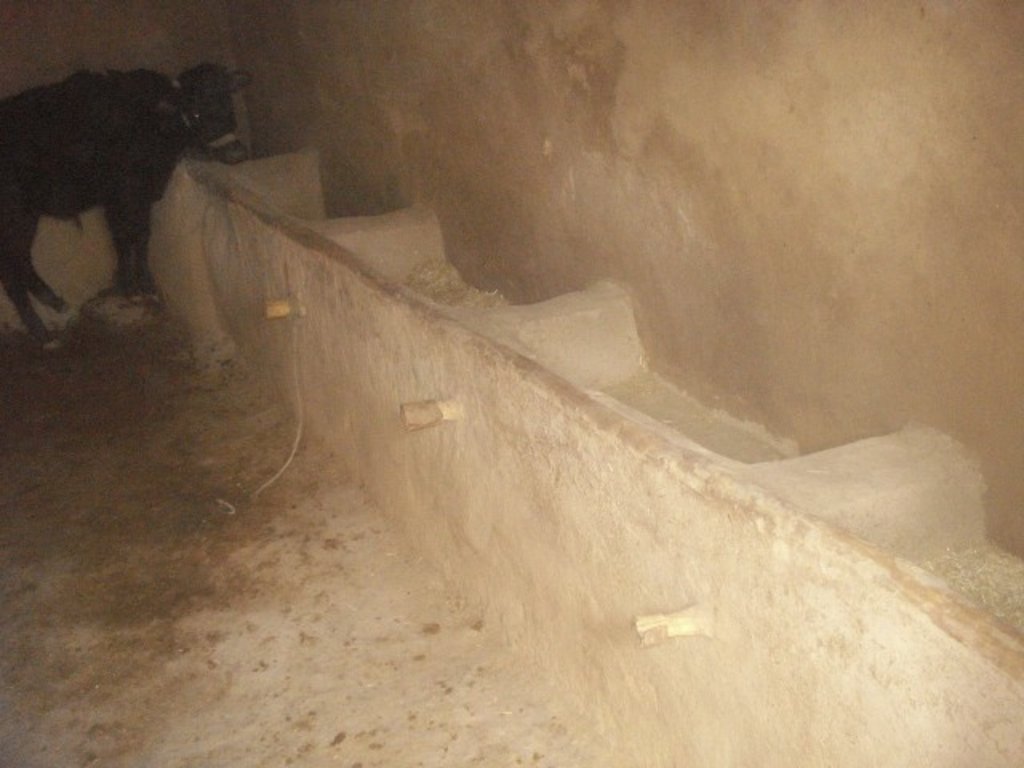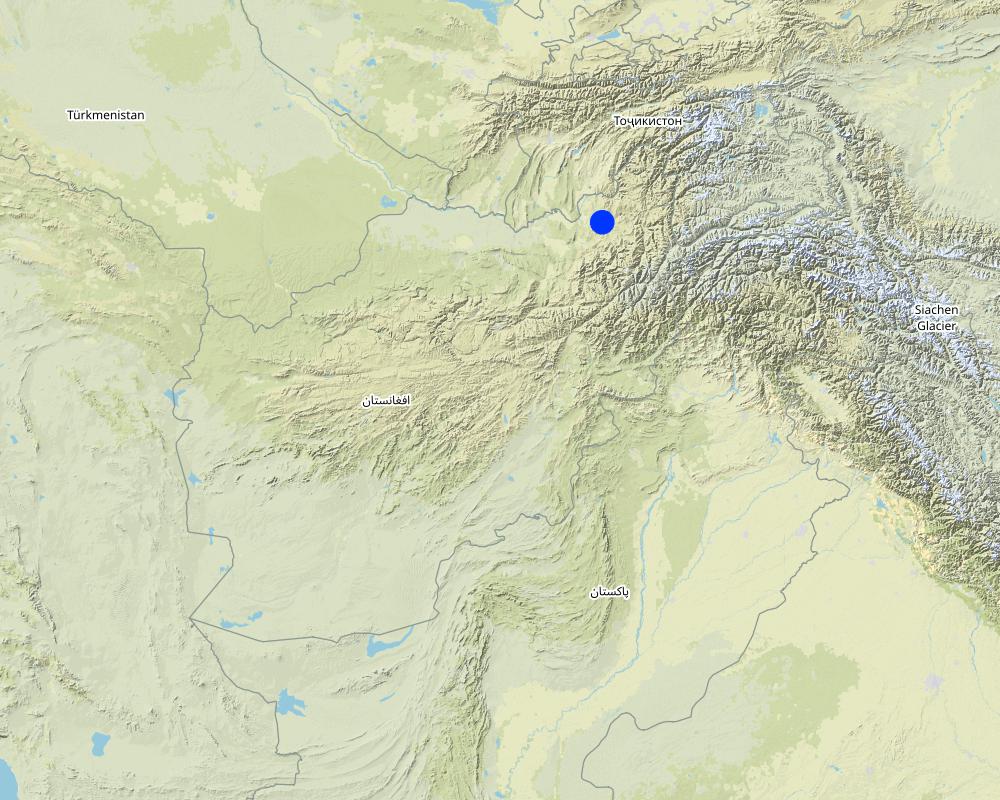Improved livestock shed for better health and productivity [阿富汗]
- 创建:
- 更新:
- 编制者: Bettina Wolfgramm
- 编辑者: MIAJAN MAROOFI, Hekmatullah Sharifzai, Roziya Kirgizbekova, Aslam Qadamov
- 审查者: William Critchley
Tabela; Oghil
technologies_673 - 阿富汗
查看章节
全部展开 全部收起1. 一般信息
1.2 参与该技术评估和文件编制的资源人员和机构的联系方式
Researcher:
土地使用者:
Alti Boy Sherogha
Natural Resources Management Committee (NRMC)
Sari Joy village, Rustaq District
阿富汗
有助于对技术进行记录/评估的项目名称(如相关)
Livelihood Improvement Project Takhar, Afghanistan (LIPT)有助于对技术进行记录/评估的项目名称(如相关)
Potential and limitations for improved natural resource management (NRM) in mountain communities in the Rustaq district, Afghanistan (Rustaq NRM Study)有助于对技术进行记录/评估的机构名称(如相关)
Terre des Hommes (Terre des Hommes) - 瑞士有助于对技术进行记录/评估的机构名称(如相关)
Swiss Agency for Development and Cooperation (DEZA / COSUDE / DDC / SDC) - 瑞士有助于对技术进行记录/评估的机构名称(如相关)
CDE Centre for Development and Environment (CDE Centre for Development and Environment) - 瑞士1.3 关于使用通过WOCAT记录的数据的条件
编制者和关键资源人员接受有关使用通过WOCAT记录数据的条件。:
是
1.4 所述技术的可持续性声明
这里所描述的技术在土地退化方面是否存在问题,导致无法被认为是一种可持续的土地管理技术?:
否
注释:
SLM practices documented in the frame of the Rustaq NRM study were established only recently (1-3 years ago). It is too early for a final judgment on the sustainability of these technologies within the human and natural environment of Chokar watershed.
1.5 请参阅有关SLM方法的问卷
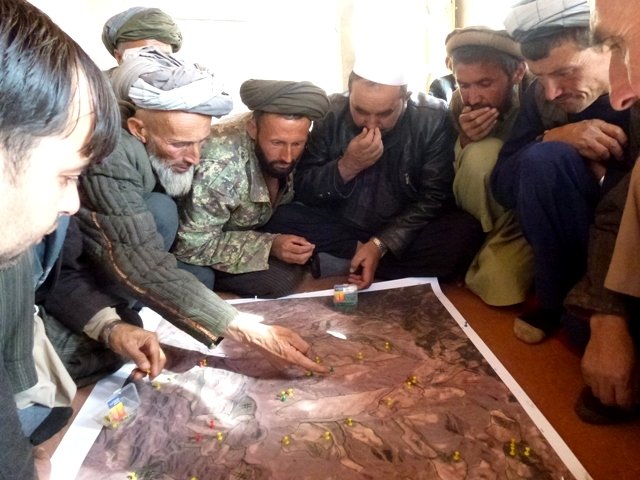
Watershed Associations (WSA) and Natural Resource Management Committees … [阿富汗]
Two Watershed Associations (WSA), in Chaker and Nahristan watershed areas respectively, are registered at the national level with the Ministry of Agriculture Irrigation and Livestock (MAIL) and at the regional level with the Department of Agriculture. Both associations are strong, active, dynamic, and have the capacity to coordinate and support …
- 编制者: Bettina Wolfgramm
2. SLM技术的说明
2.1 技术简介
技术定义:
Existing livestock sheds can be improved through interior and exterior refurbishing, and door and window installation. More favourable indoor conditions benefit animal health and the quality of animal products.
2.2 技术的详细说明
说明:
Livestock keeping is one of the key livelihood strategies in rural Rustaq - in addition to cultivation of agricultural crops. Families rely on their livestock not only for consumption of meat and dairy products, but also as means of transportation (donkeys), labour force in agriculture (oxen, donkeys) and as a source of cash income. When crops fail to produce enough, families sell their livestock to survive until the next season. The pressure to sell livestock is more acute during winter months, when cases of livestock loss increases - from diseases, lack of fodder and the harsh cold winter. These factors, along with poor conditions for livestock keeping, expose the animals to various negative impacts, affecting health, productivity and low quality/ quantity of meat and milk.
This situation is observed mainly in Sari Joy, Jawaz Khana and Dashti Mirzai villages, although Dasthi Mirzai has limited grazing land and livestock keeping is not as prevalent as in the two other villages. All three villages were selected to demonstrate improved livestock sheds, which are among the key factors for productive livestock keeping, along with stable supplies of quality fodder. Improved livestock sheds are part of the chain of activities introduced in the three villages to support livestock production, and at the same time improve the availability and quality of fodder, and restore the degraded and overgrazed pastures.
The Natural Resources Management Committee in the respective villages select a farmer, who is active in livestock keeping and already has a livestock shed. The farmer agrees to provide his livestock shed to serve as a demonstration. The farmer is supported technically and financially to renovate his shed in accordance with the defined requirements. The internal and external walls of the shed are covered with plaster made from a clay mixture to block all holes and protect the building from wind and rain. The roof is renovated to prevent leaking from snow and rain. Windows, a door and a ventilator are installed to ensure air circulation, decrease humidity levels, and protect the animals from cold and heat. A water trough and feeding racks are installed inside the shed. All the costs for the material are covered by the project. The farmer contributes with his labour.
The improved shed is vital for keeping livestock healthy. It also contributes to lowering livestock loss through decreasing the risks of diseases and cold stress during winter. The overall benefit towards livelihoods is significant, since animals are an important household asset and a coping strategy for the majority of households in the villages. The wives of the farmers benefit particularly from the renovated livestock sheds, because they are the ones who feed and water the animals, and they clean the shed of manure.
However, the costs for carrying out renovation of livestock sheds are perceived too high by the farmers. Many are unwilling to make such investments, despite the benefits.
2.3 技术照片
2.5 已应用该技术的、本评估所涵盖的国家/地区/地点
国家:
阿富汗
区域/州/省:
Takhar Province, Rustaq District
有关地点的进一步说明:
Sari Joy, Jawaz Khana, Dashti Mirzai villages
注释:
Coordinates of SLM plots owned by SLM implementers who participated in the FGD derived through the Rustaq NRM study QGIS database.
This documentation is based on the experiences of SLM implementers from Sari Joy (1 Livestock shed), Jawaz Khana (1 Livestock shed) and Dashti Mirzai (1 Livestock shed).
Map
×2.6 实施日期
注明实施年份:
2014
如果不知道确切的年份,请说明大概的日期:
- 不到10年前(最近)
2.7 技术介绍
详细说明该技术是如何引入的:
- 通过项目/外部干预
注释(项目类型等):
Livelihood Improvement Project Takhar (LIPT) supported by Swiss Development Cooperation (SDC) from 2012-17
3. SLM技术的分类
3.1 该技术的主要目的
- improve animal health
3.2 应用该技术的当前土地利用类型
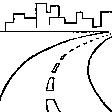
定居点、基础设施
- 定居点、建筑物
注释:
Livestock shed, cows, sheep, goats
3.4 该技术所属的SLM组
- 畜牧业和牧场管理
- Livestock management
3.5 技术传播
具体说明该技术的分布:
- 适用于特定场所/集中在较小区域
3.6 包含该技术的可持续土地管理措施
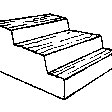
结构措施
- S9:动植物庇护所
3.8 防止、减少或恢复土地退化
具体数量名该技术与土地退化有关的目标:
- 不适用
4. 技术规范、实施活动、投入和成本
4.2 技术规范/技术图纸说明
The size of an improved livestock shed is 5 m x 3 m. The internal and external walls of the shed are covered with plaster made from a clay mixture to block all the holes and protect the building from the external elements of rain and wind. The roof is renovated to prevent leaking from snow and rain. Two windows, sized 60 cm x 30 cm and an entrance door 1.5 m x 2 m are installed. 3 ventilation pipes are installed on the roof. The installation of windows, entrance door and ventilators ensure air circulation, decrease humidity levels and protect the animals from cold winters and hot summers. A water trough and feeding racks are installed inside the shed. All the costs for the material are covered by the project. The farmer contributes through labour.
4.3 有关投入和成本计算的一般信息
具体说明成本和投入是如何计算的:
- 每个技术单元
指定单位:
Building of the livestock shed
指定体积、长度等(如果相关):
5m x 3m
具体说明成本计算所用货币:
- 美元
注明美元与当地货币的汇率(如相关):1美元=:
67.0
注明雇用劳工的每日平均工资成本:
5.2-5.3 USD
4.4 技术建立活动
| 活动 | 措施类型 | 时间 | |
|---|---|---|---|
| 1. | Selection and inspection of the livestock shed for referbishing | 管理 | |
| 2. | Design of measures for referbishment | 管理 | |
| 3. | Transportation of construction materials | 其它措施 | |
| 4. | Covering the internal and external walls with plaster | 结构性的 | |
| 5. | Installation of doors and windows | 结构性的 | |
| 6. | Installation of feed racks, water trough and ventilator | 结构性的 |
4.5 技术建立所需要的费用和投入
| 对投入进行具体说明 | 单位 | 数量 | 单位成本 | 每项投入的总成本 | 土地使用者承担的成本% | |
|---|---|---|---|---|---|---|
| 劳动力 | Transportation of construction materials | person-day | 1.0 | 52.0 | 52.0 | |
| 劳动力 | Preparation works | person-day | 2.0 | 5.3 | 10.6 | |
| 劳动力 | Rennovation works (doors, windows, water tanker and feed slot) | person-day | 14.0 | 5.3 | 74.2 | 100.0 |
| 施工材料 | Pipe for air ventilation | piece | 3.0 | 7.4 | 22.2 | |
| 施工材料 | Lime | Bag | 1.0 | 14.0 | 14.0 | |
| 施工材料 | Cement | Bag | 10.0 | 5.2 | 52.0 | |
| 施工材料 | Door | piece | 1.0 | 59.0 | 59.0 | |
| 施工材料 | Window | piece | 2.0 | 22.0 | 44.0 | |
| 施工材料 | Cloth | Meter | 12.0 | 1.8 | 21.6 | |
| 其它 | Water tank for animals | piece | 2.0 | 8.9 | 17.8 | |
| 技术建立所需总成本 | 367.4 | |||||
如果土地使用者负担的费用少于100%,请注明由谁负担其余费用:
Livelihood Improvement Project Takhar (LIPT) implemented by Terre des hommes (Tdh) Switzerland
4.6 维护/经常性活动
| 活动 | 措施类型 | 时间/频率 | |
|---|---|---|---|
| 1. | Repair of the roof with clay | 结构性的 | Autumn |
4.7 维护/经常性活动所需要的费用和投入(每年)
| 对投入进行具体说明 | 单位 | 数量 | 单位成本 | 每项投入的总成本 | 土地使用者承担的成本% | |
|---|---|---|---|---|---|---|
| 劳动力 | Repair of the roof | person day | 2.0 | 5.3 | 10.6 | 100.0 |
| 技术维护所需总成本 | 10.6 | |||||
4.8 影响成本的最重要因素
描述影响成本的最决定性因素:
Due to the remoteness of the villages where the technology has been implemented, all the inputs for establishment, such as agricultural equipment, plant material, fertilizers, etc., are purchased in Rustaq town. The expenses for traveling and delivering the inputs affect the establishment costs.
5. 自然和人文环境
5.1 气候
年降雨量
- < 250毫米
- 251-500毫米
- 501-750毫米
- 751-1,000毫米
- 1,001-1,500毫米
- 1,501-2,000毫米
- 2,001-3,000毫米
- 3,001-4,000毫米
- > 4,000毫米
指定年平均降雨量(若已知),单位为mm:
580.00
有关降雨的规范/注释:
Average annual precipitation for the area was calculated as 580 mm, with minimum in dry years (2000 and 2001) of 270 mm and maximum in wet years (2009/2010) of 830 mm. The absolute maximum rainfall was calculated for 1986 as 1024 mm. The data series covers the period from 1979 to 2014.
注明所考虑的参考气象站名称:
Reference meteorological station considered: Climate Forecast System Reanalysis (CFSR), http://rda.ucar.edu/pub/cfsr.html
农业气候带
- 半干旱
Derived from the publicly available data set on length of growing period (LGP) (Fischer 2009 / IIASA-FAO). Internet link: http://tiles.arcgis.com/tiles/P8Cok4qAP1sTVE59/arcgis/rest/services/Length_of_growing_period/MapServer
5.2 地形
平均坡度:
- 水平(0-2%)
- 缓降(3-5%)
- 平缓(6-10%)
- 滚坡(11-15%)
- 崎岖(16-30%)
- 陡峭(31-60%)
- 非常陡峭(>60%)
地形:
- 高原/平原
- 山脊
- 山坡
- 山地斜坡
- 麓坡
- 谷底
垂直分布带:
- 0-100 m a.s.l.
- 101-500 m a.s.l.
- 501-1,000 m a.s.l.
- 1,001-1,500 m a.s.l.
- 1,501-2,000 m a.s.l.
- 2,001-2,500 m a.s.l.
- 2,501-3,000 m a.s.l.
- 3,001-4,000 m a.s.l.
- > 4,000 m a.s.l.
5.4 水资源可用性和质量
地下水位表:
5-50米
地表水的可用性:
中等
水质(未处理):
良好饮用水
水的盐度有问题吗?:
否
该区域正在发生洪水吗?:
是
规律性:
偶然
关于水质和水量的注释和进一步规范:
Floods occur mainly during the rainy seasons in spring and autumn. Availability of surface water differs for the three study villages Sari Joy, Jawaz Khana, and Dashti Mirzai. Sari Joy has sources and good surface water availability. Jawaz Khana has poor water availability as water has to be fetched from a low lying stream. Dashti Mirzai has good water availability also from an irrigation channel.
5.5 生物多样性
物种多样性:
- 低
栖息地多样性:
- 低
5.6 应用该技术的土地使用者的特征
定栖或游牧:
- 半游牧的
生产系统的市场定位:
- 混合(生计/商业
非农收入:
- 收入的10-50%
相对财富水平:
- 丰富
个人或集体:
- 个人/家庭
机械化水平:
- 手工作业
性别:
- 女人
- 男人
土地使用者的年龄:
- 中年人
- 老年人
说明土地使用者的其他有关特征:
Source: Based on the data collected by CDE and HAFL.
Technology is applied belong to the Uzbek ethnic minority group Qarluq.
Although the men are generally the main land users, , women and children also take active part in the related work. The functions of men and women are clearly distinguished within the Afghan society. At the same time within the family this division of work and functions also results in men and women working hand-in-hand. An improvement of the family’s livelihood situation is expected to positively affect all family members. While, it is recognized that the involvement of women is key in order to secure basic human rights for everyone, to achieve good governance, sustainable development, and to efficiently contribute to poverty reduction (SDC 2004), it is also clear that a context sensitive approach is of great importance.
Women in rural Afghanistan are involved in many production and income generating activities that contribute to the overall household income. However, very few women own resources such as land and livestock, and their income generating options are fewer in comparison to that of men.
5.7 应用该技术的土地使用者拥有或租用的平均土地面积
- < 0.5 公顷
- 0.5-1 公顷
- 1-2 公顷
- 2-5公顷
- 5-15公顷
- 15-50公顷
- 50-100公顷
- 100-500公顷
- 500-1,000公顷
- 1,000-10,000公顷
- > 10,000公顷
这被认为是小规模、中规模还是大规模的(参照当地实际情况)?:
- 中等规模的
5.8 土地所有权、土地使用权和水使用权
土地所有权:
- 个人,未命名
土地使用权:
- 个人
用水权:
- 社区(有组织)
注释:
Those who own land and use water for irrigation are obliged to pay for the water. The payment is made both in kind and in cash to the Mirob, the person in charge of distributing water in the community. The amount of the payment varies from village to village.
5.9 进入服务和基础设施的通道
健康:
- 贫瘠
- 适度的
- 好
教育:
- 贫瘠
- 适度的
- 好
技术援助:
- 贫瘠
- 适度的
- 好
就业(例如非农):
- 贫瘠
- 适度的
- 好
市场:
- 贫瘠
- 适度的
- 好
能源:
- 贫瘠
- 适度的
- 好
道路和交通:
- 贫瘠
- 适度的
- 好
饮用水和卫生设施:
- 贫瘠
- 适度的
- 好
金融服务:
- 贫瘠
- 适度的
- 好
6. 影响和结论性说明
6.1 该技术的现场影响
社会经济效应
生产
饲料生产
畜牧生产
非木材林业生产
产品多样性
生产区域
社会文化影响
SLM/土地退化知识
注释/具体说明:
Land users learned how to implement SLM practices.
社会经济弱势群体的情况
注释/具体说明:
Female headed households are not included. Technology is implemented on private land, therefore people without land are excluded. However, they have the opportunity to earn income as a hired worker for the SLM implementers.
6.2 该技术的场外影响已经显现
有关影响评估的意见:
These comments apply to 6.1:
- Socio-economic impacts: Individual SLM implementers were asked to rate the benefits from the technology. They were asked to indicate production increase of crops; fodder; animals; wood; non-wood forest products; increase in product diversity; or production area. The most important increase they rated with 3, the second most with 2, others with 1 point. Averages of the points given by all terrace implementers are reflected here.
Ecological impacts and off-site impacts: Based on the Land User Protocols: Individual SLM implementers were asked to rate the on-site and off-site impacts of the Technology on water; soil; and vegetation. They were asked to indicate the strength of impacts with three, two or one points. Averages of the points given by all implementers are reflected here.
6.3 技术对渐变气候以及与气候相关的极端情况/灾害的暴露和敏感性(土地使用者认为的极端情况/灾害)
气候有关的极端情况(灾害)
气象灾害
| 该技术是如何应对的? | |
|---|---|
| 局地暴雨 | 非常好 |
气候灾害
| 该技术是如何应对的? | |
|---|---|
| 干旱 | 非常好 |
注释:
SLM implementers from three villages were asked to jointly discuss and rate how much the SLM technology reduced the lands vulnerability to drought and local rainstorms. Only vulnerability to the most prevalent climate extremes (drought and local rainstorms) was discussed. SLM technologies were rated as reducing vulnerability poorly , well, or very well. The average points reflected here are from multi-criteria matrices compiled in three villages where the SLM technology had been implemented.
6.4 成本效益分析
技术收益与技术建立成本相比如何(从土地使用者的角度看)?
短期回报:
非常积极
长期回报:
非常积极
注释:
Based on the multi-criteria matrix: During the FGD with SLM implementers, a multi-criteria matrix was elaborated, and different SLM practices were rated. In the frame of this exercise, SLM implementers were asked to jointly discuss and rate short term (1-3 years) and long-term (10 years) returns. As the SLM technology was only implemented 1-2 years ago, it is too early to compare benefits to maintenance costs. Farmers have little experience so far on the actual benefits of the SLM technology. The ratings are mostly based on expected benefits and not on actual benefits.
6.5 技术采用
- 单例/实验
如若可行,进行量化(住户数量和/或覆盖面积):
3 households took part in implementing the Technology
注释:
Based on the Land User Protocol: Individual SLM implementers were asked whether they received support for implementing the Technology. Each indicated the type of support he received from the proposed options: "Full Support 100%, Some Support, No Support 0%".
6.6 适应
最近是否对该技术进行了修改以适应不断变化的条件?:
否
6.7 该技术的优点/长处/机会
| 土地使用者眼中的长处/优势/机会 |
|---|
| The animals are protected from severe cold weather during the winter. The ventilation is good for keeping the air clean inside the livestock shelter. |
| Lower risks of animal diseases. |
| 编制者或其他关键资源人员认为的长处/优势/机会 |
|---|
| Improved facility, proper feeding and and watering could reduce diseases and enhance the quality of meat and milk. |
| The survival of livestock may increase potentially, particularly losses may decrease during winter. |
6.8 技术的弱点/缺点/风险及其克服方法
| 土地使用者认为的弱点/缺点/风险 | 如何克服它们? |
|---|---|
| Renovation works are too costly and many farmers cannot afford to purchase all the construction material |
| 编制者或其他关键资源人员认为的弱点/缺点/风险 | 如何克服它们? |
|---|---|
| Due to high establishment costs the practice is less likely to spread among the land users and will remain experimental. |
7. 参考和链接
7.1 信息的方法/来源
- 与土地使用者的访谈
Focus group discussions (FGD) were organized to collect information from SLM implementers in Sari Joy, Jawaz Khana and Dashti Mirzai.
- 与SLM专业人员/专家的访谈
Close collaboration took place during the compilation of this material with the technical staff of the LIPT project in Rustaq.
- 根据报告和其他现有文档进行编译
Information provided in the reports of Tdh LIPT Project in Rustaq served as an initial source of information during the preparatory phase and also solidifying the description of the technology and area of implementation. Other background papers on Afghanistan were referred to for general information on agriculture and natural resource management in Afghanistan.
7.2 参考可用出版物
标题、作者、年份、ISBN:
Guidelines for Focus Group Discussions
标题、作者、年份、ISBN:
Methods section of the Rustaq NRM study
链接和模块
全部展开 全部收起链接

Watershed Associations (WSA) and Natural Resource Management Committees … [阿富汗]
Two Watershed Associations (WSA), in Chaker and Nahristan watershed areas respectively, are registered at the national level with the Ministry of Agriculture Irrigation and Livestock (MAIL) and at the regional level with the Department of Agriculture. Both associations are strong, active, dynamic, and have the capacity to coordinate and support …
- 编制者: Bettina Wolfgramm
模块
无模块


